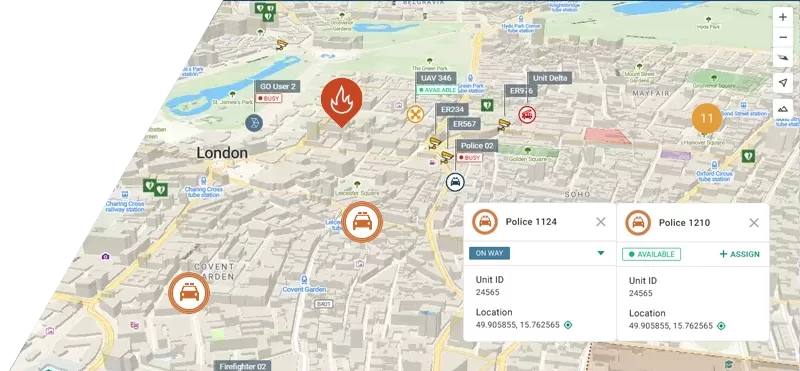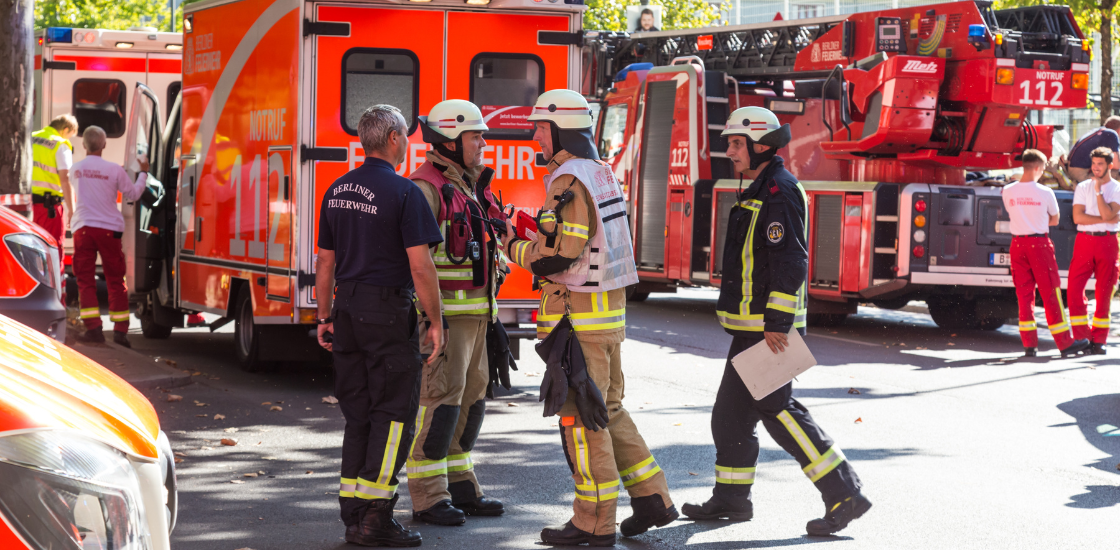In our recent article on Computer Aided Dispatch, we took a deep dive into the key features, use cases, and the benefits that modern CAD solutions bring to the table.
Now, let’s shift gears and explore some notable vendors making waves in this space, as well as the dynamics of the CAD software market.
According to the consultancy firm Research Nest, the CAD market, also referred to as Computer Assisted Dispatch, is valued at USD 3.8 billion in 2024. Based on past performance and current growth drivers, Research Nest projects the market will reach USD 20.6 billion by 2036, with a steady compound annual growth rate (CAGR) of 14.8% from 2024 to 2036.
Key Insights into the CAD Software Market:
- The growth of the CAD market is primarily driven by an increase in public safety incidents, technological advancements like the expanded use of IoT, and rising demand from governments looking to enhance citizen security.
- While cloud-based CAD installations are expected to see wider adoption across public and private agencies, on-premise CAD deployments will remain the dominant choice through the forecasted period.
- In terms of demand, North America, Europe, Asia-Pacific, Latin America, and the Middle East and Africa are set to see significant growth, with the Asia-Pacific region anticipated to hold the largest market share by 2036.
The CAD market features a wide array of vendors, some specializing solely in CAD software, while others offer a broader range of public safety and emergency response solutions.
Table of Contents
CAD Software Vendors
Each of these computer aided dispatch solutions offers robust integration options, interoperability, and a comprehensive feature set that spans call-taking, dispatching, mapping, incident management, post-incident analysis, and record-keeping.
Also, many of today’s CAD vendors support cross-agency communication in their products to streamline collaboration among emergency services, a capability that enhances response coordination during large-scale incidents.
Let’s take a look at 5 notable computer aided dispatch vendors to keep on your radar if you’re looking for a new CAD solution. What sets each vendor apart is their ability to deliver user-friendly software, language localizations, mobile apps, and integration options.
GINA Software

GINA is a European computer aided dispatch vendor focused on transforming how public safety agencies protect lives and safeguard critical assets. Since 2010, GINA has been supporting professionals in transitioning from traditional mapping methods to a fully digital, modern approach to mapping and information sharing.
Its flagship product, Smart CAD, is a comprehensive platform for rapid unit dispatching, incident management, and reporting, used by call-takers, dispatchers, field responders, and supervisors.
Smart CAD is localized in 15 languages and used in over 50 countries. It is widely adopted by international NGOs, government agencies, and a broad range of public and private sector professionals, including fire departments, EMS, law enforcement agencies, and more.
Pros: Smart CAD stands out with its straightforward interface, modern UI, and automatic alerting features (supporting VMS, IoT sensors, public SOS buttons, etc.). It places a strong focus on mobile apps and offers extensive integration capabilities with major radio manufacturers, CCTV, AVL, sensors, wearables, mobile cameras, and more.
Downsides: Limited availability in the U.S. market.
In a nutshell:
- Best fit: Small, medium, and large agencies
- Regional focus: EMEA, LATAM, APAC
- Deployment options: On-premise
- Mobile availability: Android
- Product introduction Options: Free product tour, discovery call

Fig 1: Gina Smart CAD user interface – automated dispatching.
Hexagon AB

Hexagon AB is a Swedish multinational company specializing in measurement and positioning systems, operating globally across five divisions: Asset Lifecycle Intelligence, Autonomous Solutions, Geosystems, Manufacturing Intelligence, and Safety, Infrastructure & Geospatial.
HxGN OnCall is a software suite tailored for public safety agencies, offering flexibility in deployment either as standalone modules or as an integrated system. The suite covers key aspects of emergency services operations, including dispatching, planning and response, analytics, and records management. HxGN OnCall can be deployed on-premise or in the cloud, with access via both browser and mobile apps.
Strengths: Flexible deployment options, along with the integration of AI and ML technologies to enhance decision-making and operational efficiency.
Downside: Potentially high implementation costs, which may be a barrier for agencies with tighter budgets.
In a nutshell:
- Best fit: Small to large agencies
- Regional focus: Worldwide
- Deployment options: On-premises, cloud
- Mobile availability: Android, iOS
- Product introduction: Discovery call
CentralSquare

CentralSquare is an enterprise-grade vendor providing mission-critical software for the public sector. Formed in 2018 through the merger of three major technology providers – Zuercher, TriTech, Superion – and the public safety and healthcare divisions of Aptean, CentralSquare offers a broad range of public safety and administrative solutions.
One of its offerings is CentralSquare CAD, designed to streamline and centralize emergency response workflows. This solution enables dispatchers to effectively coordinate teams and allocate resources, improving overall response times and operational efficiency.
Strengths: CentralSquare’s CAD system combines CAD-to-CAD interoperability across different agency systems with dedicated tools.
Downside: Due to its extensive feature set and complex interface, some users may face a steep learning curve, requiring training and time for full utilization by dispatchers and field personnel.
In a nutshell:
- Best fit: Medium to large agencies
- Regional focus: North America
- Deployment options: On-premise, cloud
- Mobile availability: Android, iOS
- Product introduction: Discovery call
Motorola Solutions

Motorola Solutions is a global leader in public safety communications, offering a wide range of solutions, including command center software, mission-critical communication networks, and advanced video security systems.
Its PremierOne CAD centralizes real-time information, enabling dispatchers and first responders to make informed decisions quickly. The system integrates seamlessly with Motorola’s broader suite of public safety products, including mission-critical communication systems, records management, and mobile applications.
Strengths: Integration with Motorola’s other software and hardware solutions provides agencies with a unified, comprehensive system for managing various aspects of public safety.
Downside: Due to its comprehensive nature and Motorola’s extensive range of services, the total investment required may be significant, which could be a limitation for smaller agencies with tighter budgets.
In a nutshell:
- Best Fit: Large public-safety agencies
- Regional Focus: North America, Europe
- Deployment Options: On-premise, cloud
- Mobile Availability: Android, iOS, Windows
- Product Introduction: Discovery call
Zetron

Zetron has built a strong reputation for delivering solutions that support the emergency response and public safety sectors, including fire, ambulance, and police departments, as well as utilities, transportation, and industrial operations. Its solutions are widely used across North America, with a growing presence in EMEA and Australasia.
Zetron’s MAX CAD is designed with multi-agency use in mind, integrating dispatch, GIS mapping, AVL (Automatic Vehicle Location), and interoperability with Next Generation 9-1-1 (NG911) capabilities. MAX CAD is a modular application suite, meaning its core features – CAD, mobile CAD, advanced GIS management, and the AVL module – can be bundled or integrated on an ad-hoc basis.
Strengths: MAX CAD’s scalable architecture makes it well-suited for growing agencies or multi-agency jurisdictions. Despite its robust functionality, Zetron positions MAX CAD as an affordable solution with a low total cost of ownership.
Downside: As a modular system, the initial setup, customization, and training costs can be higher compared to more basic systems.
In a nutshell:
- Best Fit: Medium to large public safety agencies
- Regional Focus: North America, EMEA, Australasia
- Deployment Options: On-premise
- Mobile Availability: Windows
- Product Introduction: Discovery call
Choosing the Right Computer Aided Dispatch Software
While some CAD solutions cater to large, multi-agency deployments with advanced analytics and extensive customization, others prioritize affordability and modularity, making them ideal for smaller teams.
What sets each vendor apart is their ability to deliver user-friendly software, language localizations, mobile apps, and integration options. These factors must be precisely assessed when choosing computer aided dispatch software, together with other factors such as total costs of ownership, vendor reliability, or responsiveness of technical support.
The computer aided dispatch market is changing fast, with vendors constantly introducing new features like real-time analytics, data visualization, IoT integrations, and mobile apps. These innovations are all designed to help dispatchers and first responders make quicker and more informed decisions on the ground, improving overall response times and efficiency.









